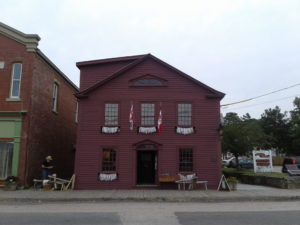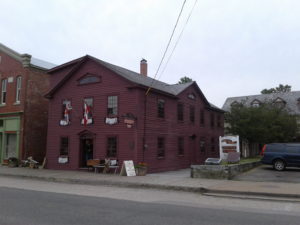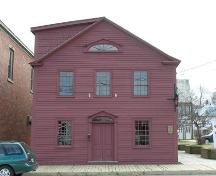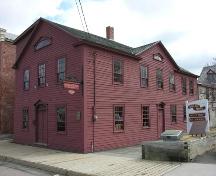230 St. George Street
230 St. George Street, Annapolis Royal, Nova Scotia, B0S 1A0, Canada
Formally Recognized: 1991/06/14
Other Name(s)
Sinclair Inn
Farmer's Hotel
Annapolis Royal Hotel
Links and Documents
Construction Date(s)
1708/01/01 to 1711/12/31
Listed on the Canadian Register: 2005/04/21
Statement of Significance
Description of Historic Place
The Sinclair Inn is a two-and-a-half storey, Georgian style building with Classical influences, located on St. George Street, in the center of the town of Annapolis Royal, N.S. The Inn is the result of the joining of an early eighteenth century French home with an Acadian style building. Both the inn and its surrounding property are included in the provincial designation.Heritage Value
The Sinclair Inn is valued for its age, construction methods and architectural history.The building that is now known as the Sinclair Inn is a combination of two pre-existing early eighteenth century buildings. The first section of the inn, the section that faces St. George Street, was once owned by Jean-Baptiste Soullard, a gunsmith and silversmith for the French garrison at Port Royal, and was erected between 1708 and 1710. The house is original to the existing location and was a full two-storey structure with a gable roof running parallel to the street. The second building, which forms the rear two-thirds of building, was built in 1711 for Dr. William Skene who was the surgeon to the British garrison at Annapolis Royal (Port Royal was transferred to the British by the Treaty of Utrecht in 1713) and a member of the Governing Council of Nova Scotia. Some of the wall cavities of the Skene house are filled with wattle and daub, a common medieval infill technique of sand and salt marsh hay.
In 1781, Frederick Sinclair amalgamated the two structures and added a new roof that extended over to the street to re-cover the Soullard house. To convey a unified building, Sinclair replaced the existing center window with a door and added a dormer on top of the door of the long façade, giving the building a Georgian appearance with Classical influences. The value in the building lies in its combination of two district buildings and in remaining elements in the building that communicate the amalgamation.
The Sinclair Inn is also valued for its role in the history of Annapolis Royal as an inn through much of the nineteenth and early twentieth centuries. Frederick Sinclair had previously operated a tavern and inn in the nearby Adams-Ritchie House until his 1781 conversion of the Skene and Soullard houses. Sinclair later expanded his business to accommodate more guests with the addition of the one and a half storey on the Skene portion of the building. Following his death, Sinclair’s widow Mary continued to run the inn until her death in 1818. The building continued to be operated a as an inn for the next one- hundred-and-thirty years, passing through many owners, closing in the 1950’s. During this time it operated under various names, including the Temperance House, Annapolis Royal Hotel, Anderson’s Hotel and the Farmer’s Hotel.
The first Canadian Masonic Lodge meeting was held in 1738 in what is now the Sinclair Inn. The Lodge was founded by Major Erasmus James Phillips, also a member of the Governing Council of Nova Scotia.
The Annapolis Heritage Society now owns the Sinclair Inn and operates it as a museum, interpreting the architectural and social history of the site.
Source: Notice of Registration of Property as a Provincial Heritage Property, Provincial Property Heritage File no. 136.
Character-defining Elements
Character-defining elements of the Sinclair Inn include:- historic clapboard on front and the street elevation;
- A-dormer on the top of the front door with fanlight;
- all Georgian style elements including: five bay symmetrical façade, fanlights, and twelve-over-eight double hung windows;
- wooden paneled doors for both street and front entrance;
- all Classical elements including: Classically detailed pediment, prominent front entrance with door mouldings, and transom;
- original interior elements including: all elements that demonstrate the Acadian and French methods of construction including waddle and daub insulated wall cavities, stenciled floorboards re-used as supports for new lathing, trim, wainscoting, and mural painted on all four walls of the second floor room facing St. George Street (presently covered by wallpaper).
Recognition
Jurisdiction
Nova Scotia
Recognition Authority
Province of Nova Scotia
Recognition Statute
Heritage Property Act
Recognition Type
Provincially Registered Property
Recognition Date
1991/06/14
Historical Information
Significant Date(s)
1781/01/01 to 1781/01/01
Theme - Category and Type
Developing Economies
Trade and Commerce
Peopling the Land
Settlement
Function - Category and Type
Historic
Commerce / Commercial Services
Hotel, Motel or Inn
Residence
Single Dwelling
Additional Information
Location of Supporting Documentation
Provincial Registry found at Heritage Property Program, 1747 Summer Street, Halifax, NS B3H 3A6
FED/PROV/TERR Identifier
00PNS0136











